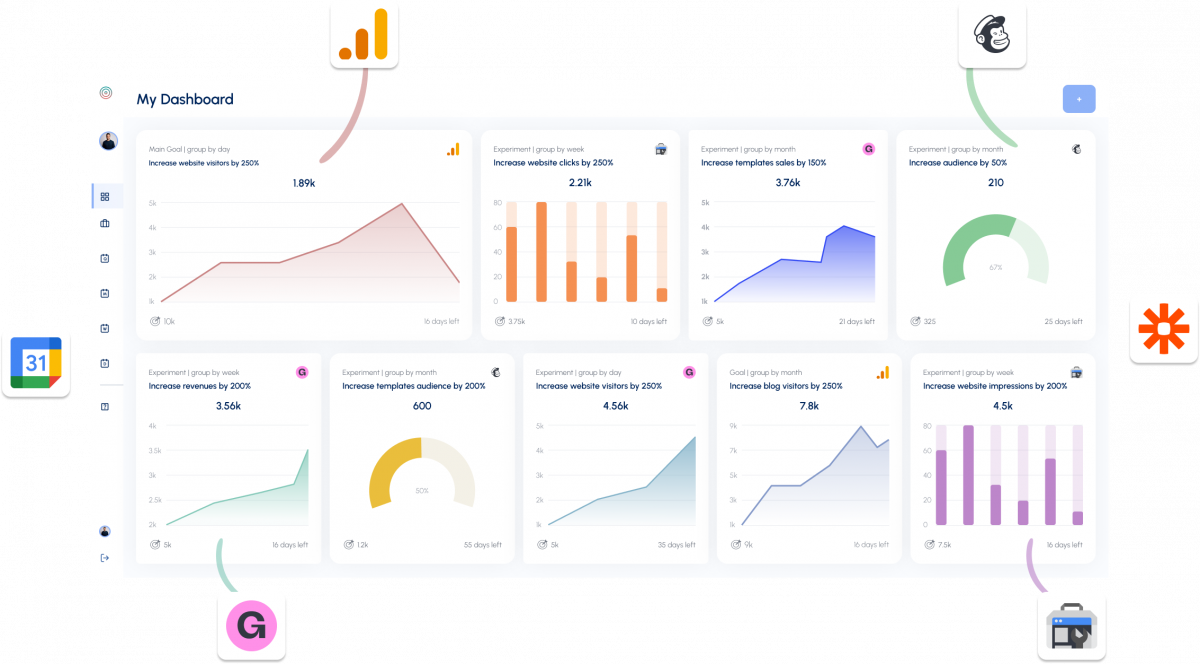Table of Contents
Introduction: The Power of Topline Metrics
Digital marketing success relies on data, but not all data is created equal. Some data provides actionable insights that directly inform decisions, while other data can be overwhelming or irrelevant, making it harder to focus on what truly drives growth. For small businesses, topline metrics offer a simplified way to evaluate overall performance and focus on growth. These high-level indicators help small business owners prioritize resources, align strategies, and track progress toward their goals—without drowning in complexity.
With limited time and resources, small business owners can use topline metrics to make informed decisions quickly. In this guide, we’ll explore how to use these metrics to drive success, integrate them with analytics tools, and maximize their potential with platforms like goalskeeper.io.
What Are Topline Metrics?
Topline metrics are high-level performance indicators that provide a snapshot of business success. They address essential questions such as:
- How is my business performing overall?
- Which marketing strategies drive the most impact?
- What trends are influencing my business growth?
Examples include total revenue, customer acquisition numbers, and website traffic—key indicators that help small businesses identify profitable channels, understand customer behavior, and measure the effectiveness of their marketing efforts. By focusing on topline metrics, small businesses can ensure every marketing effort aligns with broader business objectives.
Why Topline Metrics Matter in Digital Marketing
Topline metrics simplify data by highlighting key trends and actionable insights. Here’s why they matter:
- Measure Campaign Success: Determine which campaigns deliver the best ROI.
- Spot Trends and Opportunities: Identify emerging patterns to inform future strategies.
- Simplify Data Complexity: Focus on high-level metrics to avoid information overload.
Example:
Imagine your topline metric is total website traffic. Analyzing traffic sources reveals that organic search performs better than social media. This insight allows you to adjust your strategy, investing more in SEO while refining your social media efforts.
Key Topline Metrics for Small Businesses
To streamline your digital marketing strategy, focus on these essential topline metrics:
- Website Traffic Growth: Measure total visits and unique visitors to gauge your reach.
- Conversion Rates: Track how many visitors take desired actions, like signing up or purchasing.
- Customer Acquisition Cost (CAC): Calculate the cost to acquire each new customer and assess profitability.
- Engagement Metrics: Monitor likes, shares, comments, and click-through rates for audience interest.
- Revenue Metrics: Keep tabs on total revenue, average order value (AOV), and monthly recurring revenue (MRR).
Tools That Simplify Topline Metric Tracking
Small business owners often face time and resource constraints, such as managing marketing alongside daily operations. For example, a recent survey showed that 43% of small business owners spend less than two hours per week on marketing due to time limitations. Analytics tools can bridge the gap by providing clear, actionable insights.
- Google Analytics: Track traffic sources, conversion rates, and user behavior.
- Social Media Dashboards: Monitor platform-specific engagement metrics.
- goalskeeper.io: Consolidate all your marketing data into one dashboard for an instant overview of topline metrics.
Example in Action:
A local bakery uses goalskeeper.io to track topline metrics. By integrating website and social media data, they discover Facebook ads generate higher conversions than Instagram posts. This insight leads to better budget allocation and increased ROI.
Integrating Topline Metrics into Your Strategy
To leverage topline metrics effectively, follow these steps:
- Set Clear Goals: Use SMART (Specific, Measurable, Achievable, Relevant, Time-Bound) objectives to align metrics with your business strategy.
- Use Unified Dashboards: Platforms like goalskeeper.io provide a holistic view of your marketing data.
- Review and Adapt Regularly: Analyze topline metrics weekly or monthly to spot trends and refine your strategy.
Practical Use Case:
A small retail business identifies its highest-margin products using topline revenue metrics. By combining this insight with Google Analytics, they focus their ad spend on promoting these products, achieving a 20% sales boost.
Conclusion: Simplify Success with Topline Metrics
Topline metrics help small businesses unlock their full digital marketing potential. By focusing on high-level performance indicators, you can allocate resources effectively, refine strategies, and achieve measurable growth.
Take the complexity out of digital marketing with goalskeeper.io, which offers features like cross-channel dashboards and predefined questions for instant insights. Gain access to actionable insights, optimize your strategies, and track your progress—all in one place. Start your journey to simplified success today!
Read to next step?
Achieve Digital Marketing Success
Effortless Digital Marketing Analytics with goalskeeper.io
Start Free TrialFound in:
Digital Marketing





